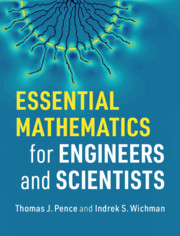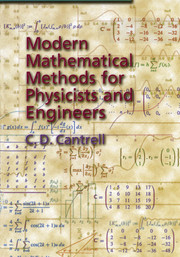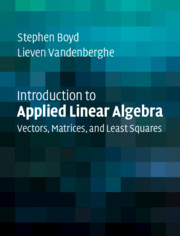Refine search
Actions for selected content:
1945 results in Engineering mathematics and programming
Dedication
-
- Book:
- Essential Mathematics for Engineers and Scientists
- Published online:
- 30 April 2020
- Print publication:
- 21 May 2020, pp v-vi
-
- Chapter
- Export citation
5 - Complex Variables: Basic Concepts
- from Part II - Complex Variables
-
- Book:
- Essential Mathematics for Engineers and Scientists
- Published online:
- 30 April 2020
- Print publication:
- 21 May 2020, pp 191-234
-
- Chapter
- Export citation
References
-
- Book:
- Essential Mathematics for Engineers and Scientists
- Published online:
- 30 April 2020
- Print publication:
- 21 May 2020, pp 729-731
-
- Chapter
- Export citation
Part I - Linear Algebra
-
- Book:
- Essential Mathematics for Engineers and Scientists
- Published online:
- 30 April 2020
- Print publication:
- 21 May 2020, pp 1-2
-
- Chapter
- Export citation
Preface
-
- Book:
- Essential Mathematics for Engineers and Scientists
- Published online:
- 30 April 2020
- Print publication:
- 21 May 2020, pp xiii-xvii
-
- Chapter
- Export citation
About the Authors
-
- Book:
- Essential Mathematics for Engineers and Scientists
- Published online:
- 30 April 2020
- Print publication:
- 21 May 2020, pp xx-xx
-
- Chapter
- Export citation
Part II - Complex Variables
-
- Book:
- Essential Mathematics for Engineers and Scientists
- Published online:
- 30 April 2020
- Print publication:
- 21 May 2020, pp 189-190
-
- Chapter
- Export citation
13 - Combined Green’s Function and Eigenfunction Methods
- from Part III - Partial Differential Equations
-
- Book:
- Essential Mathematics for Engineers and Scientists
- Published online:
- 30 April 2020
- Print publication:
- 21 May 2020, pp 666-728
-
- Chapter
- Export citation
6 - Analytic Functions of a Complex Variable
- from Part II - Complex Variables
-
- Book:
- Essential Mathematics for Engineers and Scientists
- Published online:
- 30 April 2020
- Print publication:
- 21 May 2020, pp 235-301
-
- Chapter
- Export citation
4 - The Spectrum of Eigenvalues
- from Part I - Linear Algebra
-
- Book:
- Essential Mathematics for Engineers and Scientists
- Published online:
- 30 April 2020
- Print publication:
- 21 May 2020, pp 128-188
-
- Chapter
- Export citation
2 - Linear Transformations
- from Part I - Linear Algebra
-
- Book:
- Essential Mathematics for Engineers and Scientists
- Published online:
- 30 April 2020
- Print publication:
- 21 May 2020, pp 52-91
-
- Chapter
- Export citation

Essential Mathematics for Engineers and Scientists
-
- Published online:
- 30 April 2020
- Print publication:
- 21 May 2020
-
- Textbook
- Export citation

Modern Mathematical Methods for Physicists and Engineers
-
- Published online:
- 14 September 2019
- Print publication:
- 09 October 2000
-
- Textbook
- Export citation

Introduction to Applied Linear Algebra
- Vectors, Matrices, and Least Squares
-
- Published online:
- 13 September 2019
- Print publication:
- 07 June 2018
-
- Textbook
- Export citation
Brief Contents
-
- Book:
- Optimization Concepts and Applications in Engineering
- Published online:
- 31 May 2019
- Print publication:
- 06 June 2019, pp v-vi
-
- Chapter
- Export citation
6 - Penalty Functions, Duality, and Geometric Programming
-
- Book:
- Optimization Concepts and Applications in Engineering
- Published online:
- 31 May 2019
- Print publication:
- 06 June 2019, pp 254-286
-
- Chapter
- Export citation
8 - Multiobjective Optimization
-
- Book:
- Optimization Concepts and Applications in Engineering
- Published online:
- 31 May 2019
- Print publication:
- 06 June 2019, pp 328-350
-
- Chapter
- Export citation
11 - Optimization Applications For Transportation, Assignment, and Network Problems
-
- Book:
- Optimization Concepts and Applications in Engineering
- Published online:
- 31 May 2019
- Print publication:
- 06 June 2019, pp 389-408
-
- Chapter
- Export citation
9 - Integer and Discrete Programming
-
- Book:
- Optimization Concepts and Applications in Engineering
- Published online:
- 31 May 2019
- Print publication:
- 06 June 2019, pp 351-374
-
- Chapter
- Export citation
Contents
-
- Book:
- Optimization Concepts and Applications in Engineering
- Published online:
- 31 May 2019
- Print publication:
- 06 June 2019, pp vii-xii
-
- Chapter
- Export citation
